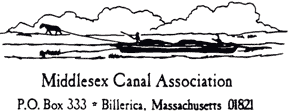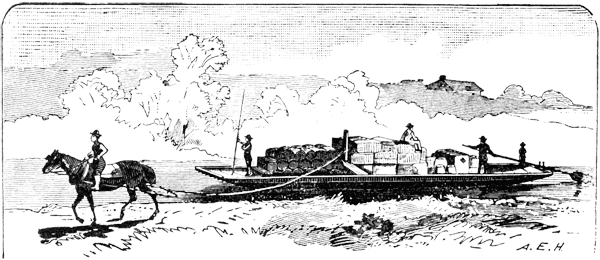


Middlesex Canal Association P.O. Box
333 Billerica, Massachusetts 01821
Volume 31, No. 1 September, 1992
29TH ANNUAL MIDDLESEX CANAL FALL WALK
SATURDAY, OCTOBER 17, 1992 at 2 P.M.
(Rain date: Sunday, October 18)
Jointly sponsored by MCA and AMC
Meet at 2 p.m. in Wilmington at the Town Forest parking lot on the left side (going north) of Route 38, 2.4 miles north of Route 128 and directly opposite the Continental Cablevision building.
Bring your family and friends for this walk along a delightful section of the old Middlesex Canal. After seeing the "oxbow" and grooves worn in the rock by countless tow ropes, we will cross Maple Meadow Brook at the remains of the old aqueduct and go north along the portion of the canal given to us several years ago by Stanley Webber and his daughter Julia Fielding. We will cross Butters Row and continue on to Patches Pond where we will turn around and retrace our steps to the Town Forest. It will be a leisurely walk of about 2 miles round trip, with ample time for occasional stops for questions and remarks about the history of the Canal.
MORE UPCOMING EVENTS
Mark your calendar now to save these dates!
FALL MEETING
Sunday, November 15, 1992
Our fall meeting will be held in Chelmsford at 2 p.m. at the Chelmsford Unitarian/Universalist Church.
The program will be a slide show on our own Middlesex Canal, presented by Nolan Jones. Nolan is thoroughly versed on the Canal, having been a proprietor for many years, a past president, and a past treasurer/membership secretary. This will be a good opportunity, especially for newer members, to learn more about the Canal, its route, details, and interesting historical information.
As usual, the meeting is open to the public. So bring your friends and stay after the meeting for refreshments and socializing.
DIRECTIONS: The Unitarian/Universalist Church (with tower clock) is located at the center of Chelmsford. There is limited parking at the church. Additional parking is at the Old Town Hall on North Road, and at the First Bank & Trust Company, with entrance from Billerica Road (Route 129).
DEDICATION OF THE JOSEPH V. KOPYCINSKI COLLECTION
For many years until his death in 1987, Joe Kopycinski was a director of our Association, Editor of "Towpath Topics," and custodian of our Middlesex Canal archives. Joe served in a variety of leadership positions in the libraries of the University of Massachusetts Lowell from 1950 until his death.
The University is dedicating a collection in the O'Leary Library on the South Campus in honor of Joe. The ceremony will take place in Lowell at the O'Leary Library on Sunday, October 25, at 2 p.m.
Those wishing to attend the dedication should RSVP to Dr. Ben Franckowiak, Library Director by October 15. His telephone number is (508)934-4577.
PRESIDENT'S MESSAGE
Most of our doings since the last issue of "Towpath Topics" are well covered elsewhere in this issue, so I will only mention them here: a Canal clean-up day in Billerica, the Annual Meeting in April, hosting a group from the British Inland Waterways Association in June, and advance planning for the 200th anniversary dramatization of the Middlesex Canal's commencement.
I have good news. Nolan Jones has retired and has moved back to this area after seven years in Seattle. He was formerly our treasurer, membership secretary, and president. Welcome back, Nolan! We hope to be beneficiaries of your active participation again.
Nolan has already consented to show his Middlesex Canal slides at our meeting in November (see details on previous page).
Burt VerPlanck
President
SPRING MEETING 1992
On Sunday, April 26, 1992, the members and guests of the Middlesex Canal Association met for the Annual Meeting at the Royall House in Medford.
We began with a tour of this magnificent Georgian mansion, of which the oldest part dates to 1723. Col. Isaac Royall obtained the property in 1732 and rebuilt the house in its present form. The Royall House Association has done a magnificent job in preserving and restoring the house to appear as it did in the 18th century. We are grateful to MCA Proprietor Carl Seaburg, a member of the Royall House Association, for arranging this rewarding tour.
After the house tour, the attendees returned to the slave quarters of the Royall House for our Annual Meeting, and program. Larry and Marjorie Glassco of Fredericksburg, VA, presented a slide show of a recent tour on the "Caribbean Prince" of the American Canadian Caribbean Cruise Lines. The trip was a fall foliage tour of the St. Lawrence River, Lake Ontario, the Oswego Canal, the Erie Canal, the Hudson River, and Long Island Sound. Marjorie was actually raised along the Oswego Canal, and talked about her memories of that waterway.
Following the program, many of the members visited the two Canal plaques in Medford, a short walk from the Royall House.
CANAL CLEAN-UP IN BILLERICA, MAY 1992
(contributed by Carolyn Osterberg)
On Saturday, May 16, 1992, Troop 30 of the Billerica Boy Scouts joined with members and friends of the Middlesex Canal Association in a clean-up project of the section of Canal running from Dignon Road to Brown Street in Billerica. This section was given to the Association 11 years ago by Frank Dignon.
Highlight of the clean-up was hauling 55 tires out of the Canal. The Town of Billerica accepted the tires for a $2 per tire disposal fee
Congratulations for the fine work of all who participated in the clean-up!
THIS TIME THE "REDCOATS" WERE TOURISTS!
by Bill Gerber
For three weeks in June, a group of about thirty British men and women invaded the northeastern USA and part of southeastern Canada. In contrast to an earlier time in our history, this "invasion force" was quite peaceful; it consisted of members of the British Inland Waterways Association (IWA), who came to tour active and historic American Canals. They were aided in their planning and travels by members of the American and Canadian Canal Societies (ACS/CCS) and a succession of state and local canal and railway organizations. Starting in Boston, they traveled through New England, New York, New Jersey, Pennsylvania, Washington DC, Maryland, West Virginia, and on into Canada. As they passed through Buffalo, NY, they took a prominent part in an international conference of canal organizations.
(The IWA is the advocacy and activist organization that has been responsible for the conservation and restoration of more than 3000 miles of early British canals for recreational boating and other purposes; an endeavor that continues today.)
Betty Bigwood, Bettina Harrison, and I, from the Middlesex Canal Association (MCA) and ACS, met the group at Logan Airport in the early afternoon of June 9 and escorted them to a "gem" from New England's historic past - the Saugus Iron Works National Park. After a "tea" break - in this case iced tea and soft drinks, all part of the Americanization process! - a Park Service Ranger took them on a tour of the site.
(Credited as the birthplace of America's iron and steel industry, and researched and restored with funding by that industry, the Saugus Iron Works flourished in the mid-1600's, when it was one of about a dozen "modern" iron producing sites worldwide. The site contains the original Iron Master's House, and reconstructions of the Foundry, the Forge, the Rolling and Slitting Mill, and the canals and water wheels that provided power to operate them. A blacksmith's shop, greeting center and gift shop, and a small museum are also located there.)
From the Iron Works we proceeded to "Baldwin's" for a reception and dinner. Since we were a bit early, many of the group walked a section of the Middlesex Canal towpath before returning to the restaurant's large function room. We were joined here by additional members and friends of the MCA and ACS. Soon the conversation became lively, and dinner was superb. After dinner, Rich Scott (Superintendent of Lowell State Park) and Dave Barber (canal authority and board member of the MCA, member of the ACS and many other canal societies) provided a preview of the forthcoming days' activities. That the visitors were still alert when the evening ended, at about 3 a.m. London time and after a six-hour plane ride is a testimony to British fortitude!
(Now an excellent restaurant, "Baldwin's" was once the home of Colonel Loammi Baldwin, Chief Engineer for the Middlesex Canal and discoverer of the apple that bears his name. The house is situated beside a restored section of the Canal, having been moved there in the 1970's from the vicinity of the nearby Ames Plaza.)
Rich Scott met our visitors the following morning at the Lowell Sheraton Hotel, to guide them on a tour of the mills and canals of Lowell National Park. En route, Rich performed several renditions of living history from his abundant repertoire, which seems to have been genuinely appreciated. The admiration was mutual; Rich noted that the group exhibited an unusual breadth and depth of knowledge and were a joy to guide.
Jane Drury and I met the group for lunch at the "Melting Pot," a restaurant situated next to the Lowell National Park Headquarters. In the afternoon, Jane conducted a tour of the Middlesex Canal from its junction with the Merrimack River to the Shawsheen Aqueduct. En route, we detoured by the old Middlesex Canal Tollhouse, now located on the Common in Chelmsford [see article elsewhere in this issue of "Towpath Topics"), and stopped in North Billerica at the site of the Merrimack Branch Guard Lock and the famous Floating Towpath that once spanned the Concord River. Here we also held an impromptu session on Poison Ivy recognition, a hazard unknown in the UK! The lesson was repeated by Dave Barber the following day; it seems to have been successful!
Following the tour, the Brits took the evening off to roam about Lowell and dine on their own.
The group departed early Thursday morning, pack lunches in hand, for a rendezvous with Dave and Audrey Barber. The Barbers led them on a tour of the Blackstone Canal to below the Massachusetts-Rhode Island border, and then, almost impulsively, took them on to see the Windsor Locks Canal.
(Opening in 1828, the Blackstone Canal provided Worcester with access to Narragansett Bay at Providence. The Canal continued in operation until about 1848, shortly after it was paralleled by the Providence-Worcester Railway.)
After a long day, the group departed for their next stop, and a new group of guides, at Kingston, New York.
[Besides being a member of the Board of Directors of the Middlesex Canal Association, Bill Gerber is a Vice President of the American Canal Society.]
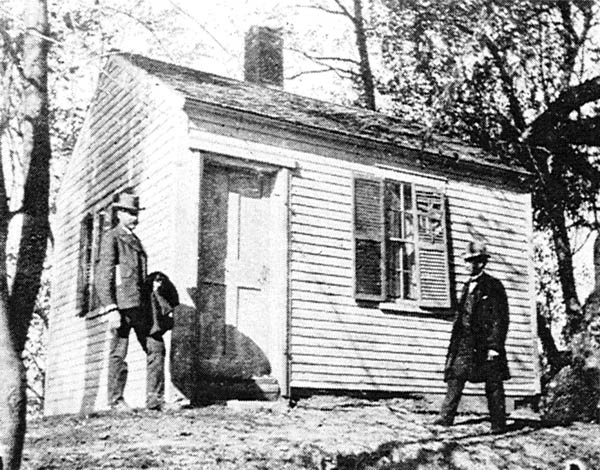
The Middlesex Canal Tollhouse as it looked in Middlesex Village.
This photograph is one of a collection taken mostly in the early 1930's by James L. Faden (see "Towpath Topics," March 1992 issue).
MIDDLESEX CANAL TOLLHOUSE FOR LANDING #8
by Jane Drury
The original Middlesex Canal tollhouse/office in Middlesex Village (now part of Lowell) occupied about a third of the Canal storehouse, which stood near the end of the Canal at the Merrimack River. In 1832, a new tollhouse and collector's office was erected on the western bank of the Canal, a few yards closer to the locks that lowered the Canal down to the river.
On September 5, 1855, following the demise of the active canal, the property including these two structures was sold by the Middlesex Canal Corporation to Judge Samuel P. Hadley, a former Canal employee, whose father had been in charge of the locks and business of the Canal there, as well as tollkeeper. The storehouse was sold to a Mr. Greenleaf and moved to Ayer's City, another part of Lowell. The tollhouse remained at its original site for many years, during which time Mr. Hadley hoped that if would not be destroyed by "tramps and mischievous boys." During the 1930's, his widow, concerned about its deterioration, had it moved to the Proctor Lumber Yard in North Chelmsford. Its old feather-edged clapboards were replaced, its interior and exterior restored by an employee of the lumber company, and it was rededicated and opened to the public. There it remained for about twenty years, unnoticed by most people.
The tollhouse made its next journey in 1955, when the Hadley heirs sold the tollhouse to the Town of Chelmsford, which was celebrating its tercentenary. It was moved to the front lawn of the town hall in Chelmsford Center and used as an information booth. After the close of the celebration, the tollhouse traveled across the common and out of sight behind a one room school built in 1902. It was returned to the town hall lawn for the 1976 celebration, after which some of the town fathers became determined to have "that old shack" torn down. Preservation won out, however, and the evicted tollhouse moved, hopefully for the final time, to its new foundation on the Chelmsford Common.
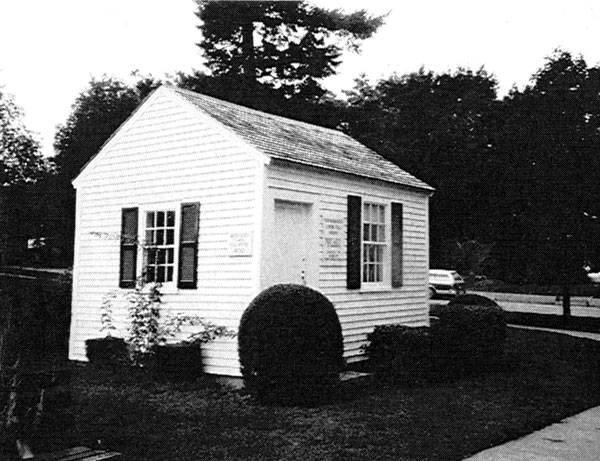
The Middlesex Canal Tollhouse in its new location in Chelmsford
Sign by door reads:
Old Middlesex Canal Toll House
Oldest Canal Toll House in America
Donated by Heirs of
Judge Samuel P. Hadley
Sign on side of Tollhouse reads:
Middlesex Canal Toll House
1832
(Photograph courtesy of Tom Raphael)
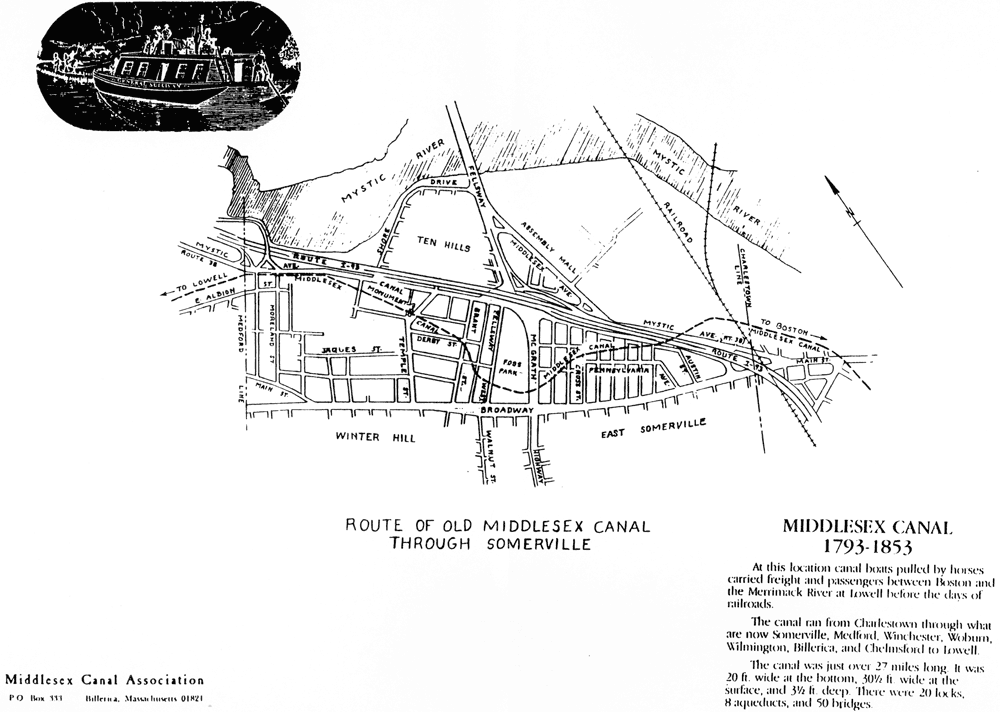
A SHORT HISTORY OF THE MIDDLESEX CANAL ASSOCIATION
by Arthur L. Eno, Jr.
(First President of the Middlesex Canal Association)
In honor of the thirtieth anniversary of the Middlesex Canal Association and of the approaching bicentennial of the Canal Corporation, I have been asked to sketch out the history of the Association. Even to one who has been present since the beginning, the events and accomplishments of the last thirty years are impressive.
The Association was founded as the result of a rousing talk on the Canal at a meeting of the Billerica Historical Society in 1962. The speaker was Harry J. Lasher, who challenged those present to do something about preserving the old Canal. Lasher was the artist who produced the magnificent illuminated map of the Canal that has found its way into the Association's collection.
A group of devotees, mostly from Billerica, proceeded to organize, and then, on May 27, 1964, to incorporate the Middlesex Canal Association. Among the early recruits were Col. Wilbar M. Hoxie of the Army Corps of Engineers, who produced the historical and technical map of the Canal that the Association published; and Mary Stetson Clarke, the well-known author, who learned of the Association while researching a novel about Loammi Baldwin entitled The Limner's Daughter. Having done so much research for the novel, Mary Clarke then published the definitive history of the canal, The Old Middlesex Canal.
From the beginning, the Association has sponsored, with the Billerica Boy Scout troop and the Appalachian Mountain Club, an annual Canal walk, attended by an enthusiastic group through rain and shine, and even once during the tail end of a hurricane.
In 1967, the Association received members of the Canal Society of New York and the Pennsylvania Canal Society for a regional meeting, at which the American Society of Civil Engineers presented a plaque designating the Shawsheen Aqueduct in Billerica as a National Civil Engineering Landmark.
As the Association began to receive gifts of artifacts, documents, and memorabilia, it established a Canal exhibit in a room of the Billerica Historical Society house. In 1970, an arrangement was made with the Lowell Technological Institute (later the University of Lowell and now the University of Massachusetts at Lowell) to deposit the collection in the University Library. Along with several other historical collections, the Canal material is now a major part of the Center for Lowell History at the Mogan Cultural Center in Lowell. Among the many gifts to the collection are a water color of the Baldwin Mansion by Louis Linscott, as well as some of his prints, and oil paintings of the Canal by Joseph Peyro.
1972 - the tenth anniversary - was a notable year. The Canal was listed on the National Register of Historic Places, and the Middlesex County Commissioners turned over to the Association for safekeeping the original records of the Proprietors of the Middlesex Canal, which had been deposited with the County since the corporation was dissolved in 1859. These records are now part of the collection and are available to scholars and interested canal buffs at the Center for Lowell History.
In 1974, when the Route 129 bridge over the Canal in Wilmington was being rebuilt, the Association persuaded the State to restore a section of the Canal near the bridge. The Association sponsored the dedication ceremony, complete with barge and the traditional bagpipe band. In 1976, the Association hosted a meeting of the American Canal Society in Lowell.
1979 was another banner year. Thanks to the efforts of State Representative Nicholas Paleologos, the legislature passed a bill establishing the Middlesex Canal Commission, consisting of representatives of each town along the route of the Canal, to investigate and plan a Heritage State Park. Governor Dukakis signed the bill after enjoying a ride on the "Colonel Baldwin" canal barge, built and launched by the Woburn Historical Society under the leadership of Leonard Harmon. The barge was part of a larger project, which involved moving the Baldwin Mansion across Route 38 to its present site on the bank of the Canal. When the original site of the Mansion was acquired for shopping center parking, the Woburn Historical Society persuaded the owners to donate the house - and even to contribute a sum toward the moving. The house was moved across the highway to a location on the bank of the Canal and has been restored into a fine restaurant appropriately named "Baldwins." For several years it was the starting point for horse-drawn canal barge tours aboard the "Colonel Baldwin."
Starting with a gift from the North Billerica Company of a small parcel of land on the east bank of the Concord River at the entrance of the Canal, the Association has slowly increased its ownership of sections of the Canal. Generous gifts from Frank Dignon in Billerica (1981), Stanley Webber and his daughter Julia Fielding in Wilmington (1983), and an easement from the United Parcel Service in Chelmsford (1988), ensure the preservation of substantial sections of the Canal.
From its beginning, the Association has published a newsletter/magazine called Towpath Topics that combines current news, contemporary articles and historic reprints. The Association also has published the Hoxie Map, Mary Stetson Clarke's Guide to the Middlesex Canal, and a portfolio of Canal prints by Louis Linscott.
This is an impressive record - especially considering that the Association has been largely responsible for preserving what is left of the Canal as well as increasing public awareness. As it continues into the second half of its first fifty years, the Middlesex Canal Association now has an important place among recognized and elder canal societies with a strong and eager membership. Long may it prosper!
GROWING UP ON THE C&O CANAL
by Douglas Bruce McHenry
In 1940, when I was 9 years old, I moved with my father, mother, and brother into a 200 year old lockkeeper's house on the Chesapeake and Ohio Canal. The National Park Service had recently renovated the house to be used for employee housing. They had stabilized the two-foot thick stone walls, replaced all the old sills and flooring, raised the roof eighteen inches and added three dormer windows. Raising the roof allowed more space for two garret bedrooms and a very small bathroom, which made it more livable. Originally the cottage had only two small rooms on the ground level, each with a fireplace, no water, and of course no electricity. This cottage was my home for the years 1940-46. It was here that I learned a lot about canals.
Lock No. 7 at Glen Echo, Maryland, was unusual in that it had a chamber fitted for an upstream drop gate, quite different from its lower swing gate. The drop gate was filled with stones, which counterbalanced the gate. The gate was lowered and raised using a geared chain winch. Barges would pass over the lowered gate when entering or leaving the filled lock chamber. The two butterfly valves were housed in the stone walls on either side. The gate was easily operated by one person. I often operated it myself, unaided.
In the early 1930's, the C&O Canal had been destroyed by floods along the Potomac River. By 1934, the WPA and CCC had been put to the task of rebuilding the lower section of the canal from Seneca to Georgetown. The most difficult section to rebuild was the section known as Wide Water. This section of the Canal was just below Great Falls, and it required the reconstruction of a massive stone embankment between the Canal and the river. All of the banks and over 20 locks were rebuilt, and the 25-mile section was rewatered from the Seneca feeder canal to Georgetown.
My father, who was the Chief Naturalist for the National Capitol Park, NPS, was easily enlisted in the battle to save and restore the C&O Canal in its entire length, Cumberland to Georgetown. The railroad had purchased the Canal for its right of way. They wished to sell all or part of its length. The National Park Service was interested in preserving the Canal but couldn't get funding. At the same time, other interests were proposing high dams along the Potomac River, which would bury the Canal. Still others proposed a scenic parkway on the filled-in Canal. In order to increase public interest in the Canal, my dad proposed several activities.
Among the earliest was a highly publicized canoe trip from Cumberland to Georgetown, which would use as much of the old C&O Canal as remained. Dad and three other men, including a news reporter and a photographer, made the camping trip in about a week. It did attract considerable media attention. I recall locking them through in front of our house.
As people learned of the Canal, more and more pressure to restore it developed. The lower 25 miles was in excellent working condition at that time. It was being used by canoes more and more.
My dad saw an opportunity to use the Canal as an interpretive medium. He wanted to run a barge in the restored section to give people the unique feeling of traveling a canal. This would give the National Park Service and the canal proponents more visibility. After he received the go-ahead, he and I visited the US Navy in Anacostia to look over old barges. I remember holding the end of the steel tape as we looked for a flat barge which would fit into a lock.
When we found one, we asked the Navy if the NPS could borrow it. Dad was very persuasive and he got his wish. It was a nondescript, flat barge, but it floated and could fit into a lock chamber with inches to spare. Next, dad had the NPS maintenance build a cabin and fit the barge with a rudder and all the necessary tow lines and davits. Benches and a canopy were added for passenger comfort. Dad had already found an old canal skipper and the mules and a driver.
The newly outfitted barge was christened the Canal Clipper. On its maiden voyage, upstream, I went along to help with the locks. The invited guests included many NPS dignitaries, plus members of congress and senators and their families. My dad and his staff did the interpretation. It was a two-day trip, with buses carrying the passengers home for the night, and back. We eventually reached Seneca. The trip certainly attracted lots of media attention. Although I am not sure another such trip was made, this one certainly struck a stout blow toward saving the Canal.
During this period, I began to explore the Canal on my own and with my family. This was during World War II and gasoline and other scarce items were rationed. This meant that travel was limited, except on public conveyances. My dad worked out an arrangement with the Capitol Transit Company to provide excursion buses for special interpretive tours. Several of these tours were to parts of the Canal which were not often visited during the War. One such tour visited the Monocacy Aqueduct, south of Frederick, Maryland. It was one of the longest such structures in the United States. It was made of granite taken from nearby Sugar Loaf Mountain, which we also toured. We also went through one of the longest canal tunnels in the United States at Paw Paw.
The pressure for dams and a parkway continued, however. A small group of conservationists met on our side porch one evening and came up with an idea which finally saved the C&O Canal. They knew that Justice William O. Douglas was a regular hiker along the towpath, although not many people recognized him at that time. My dad and this group of influential conservationists conceived of inviting Justice Douglas to "go public" with his walk, to publicize the use of the Canal by people and the need to preserve it. Justice Douglas was delighted and, of course, as they say, the rest is history.
Today the Chesapeake and Ohio Canal is a National Park. Unfortunately, it, like many historic sites has suffered from overuse and lack of maintenance funding. Only the lower portion of the Canal is watered now. The new Canal Clipper rides a section from Georgetown to Lock 5. A similar barge is towed by mules through one lock adjacent to the Great Falls Visitor Center. Unfortunately, a flood in the late 1940's wiped out Wide Water again, so that this beautiful section of canal is dry. Sections of the Canal above Seneca are also watered. The locks and aqueducts are in ruins upstream. Sadly, my boyhood home at Lock 7 has been unoccupied for years and has fallen into disrepair.
I returned to Washington to work for the NPS in 1961. My colleagues and I spent many wonderful hours walking with our young families along the Canal. I have covered every mile of this Canal, and it truly deserves preservation. If you ever visit Washington, do set aside time to walk the C&O Canal.
[Bruce McHenry is a Director of the Middlesex Canal Association.]
ADVANCE NOTICE
AN HISTORICAL REENACTMENT: LAUNCHING THE MIDDLESEX CANAL
(by Tom Raphael)
In October 1793, a noteworthy event took place in Medford, Massachusetts. A dozen outstanding business leaders and political figures met to plan the building and financing of the Middlesex Canal, connecting Boston with the Merrimack River and thereby with New Hampshire. The venture was to have dramatic impact, establishing a corridor to the north that would help secure Boston's position as the key city of the Commonwealth, and at the same time develop a healthy economy for eastern Massachusetts.
At a time when railroads were nonexistent and highways barely passable, the Canal reflected the fever of waterway construction that had already swept Europe. However, the concept was risky: all digging and construction would have to be done by hand, the route itself was only roughly outlined, and the rewards were uncertain. Those gentlemen present at the meeting were farsighted and courageous, to say the least; their vision and energy make a remarkable story.
The Middlesex Canal Association has chosen to dramatize that crucial meeting with a theater-in-the-round reenactment. It will take place just 200 years afterwards, on October 17, 1993. The original meeting took place in Union Hall of the old Blanchard Tavern; the performance will be presented within sight of that location, namely, at the hall of the Medford Senior Center beside the Mystic River.
The reenactment will faithfully capture the flavor of the period, and the costumed players will assume the roles of original participants, several of whom went on to serve important positions in the Commonwealth, such as Governor. One, Loammi Baldwin, came to be acknowledged as a founder of the American civil engineering profession. The many aspects of the venture, including design, construction, operation, investment, and revenue, will emerge from the participants' lively discussion.
This reenactment is intended to be the first in a series of events to commemorate the building of the Middlesex Canal. In subsequent years, other highlights will be featured, such as the groundbreaking at North Billerica, where a floating towpath crossed the Concord River, itself the source of water for the Canal. Later, we hope to celebrate the opening of various segments of the Canal to towns along the route, culminating in the successful completion of the Canal and the start of full operations in 1804.
This Advance Notice is being directed to historical societies, civil engineering groups, libraries, and other organizations that may be interested in the Canal, to encourage their participation in developing the event into its proper significance and impact. We look forward to a memorable experience in Medford a year from now on Sunday, October 17, 1993.
SPEAKERS NEEDED
Do you know of someone who'd make an interesting speaker for a meeting of the Middlesex Canal Association? (Including yourself?) Or is there some special author or scholar you've always wanted an excuse to call and introduce yourself to? Why not invite him or her to be a guest speaker at one of our meetings? For further information, or just to pass along your ideas, please contact any of our association's Officers and Directors.
CONTRIBUTIONS NEEDED FOR TOWPATH TOPICS
Your editor would be delighted to receive from any of our members contributions for inclusion in Towpath Topics. You can send them to me: Martha L. Hazen, 15 Chilton St., Belmont, MA 02178. If you have any questions or comments about this newsletter, please feel free to call me at 617/484-3634.
